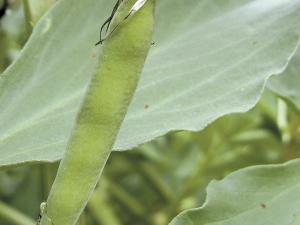Fava beans differ from familiar garden varieties
Before the discovery of the New World they were the only beans Europe knew. They have a distinctive flavor and are remarkably hardy. Sometimes called broad beans, or even “horse beans” because the adjective horse means strong or coarse in other words such as “horseradish” or even “horseplay.”
Fava beans (Vicia faba) are best known for being unknown. Most Americans have never seen, much less tasted, fava beans. With a taste like a lima bean crossed with a navy bean, they are best known in Mediterranean and British cooking when featured in Cicorie con Fave (Chicory with Fava Beans), Penne con Fave (Penne Pasta with Fava Beans) or simply Pecorino Cheese and raw fresh fava beans.
Unfortunately, fava beans differ from familiar garden beans in another way. Before you can eat them you need to blanch them in boiling water to remove the waxy outer coating.
So instead of growing fava beans for the beans, why not grow fava beans for fava greens? Fava bean leaves and young stems are not only completely edible, they are a delicacy. Fava greens have a sweet, grassy, yet buttery taste that has a hint of the distinctive nutty fava bean flavor. Fava greens can be eaten raw in salads, pesto or wherever you use spinach or Swiss chard. Try the greens in a wilted salad with hot bacon dressing.
Rather than wait 75 days or more for beans, you can harvest fava greens almost any time. The pointed 13-inch-long leaves are soft, velvety deep green. Fava beans will begin to bloom in about six weeks. Many garden stores and nurseries carry fava bean or broad bean seeds. Most fava beans bloom with sweet pea-type white flowers with black centers. For a brighter show, try growing Crimson Flowered Fava, an heirloom from 1778 whose brilliant red blooms make it pleasant enough for the flower garden.
Fava beans grow best in cool weather. Sow the large, lumpy seeds one to two inches deep, four to six inches apart, in rows 18-36 inches apart. The bushy, upright plants will eventually reach two to four feet tall. Fava beans grow best in rich soil in full sun, yet can survive in everything from clay soils to seaside soils with high salinity.
Because fava beans are legumes they can fix nitrogen from the air and add it to the soil. It helps to dust the seeds with a powdered inoculant that contains the nitrogen-fixing Rhizobium bacteria.
Pick fava greens continuously to encourage more leaf growth. Fava greens will keep in the refrigerator unwashed for up to five days.
You can also plant fava beans as a soil-building green manure crop to add nitrogen and organic matter to your garden. Mow the plants down or till them directly into the soil just as they begin to bloom.
One more thing about fava beans. Some people, especially males of Mediterranean descent, have a genetic condition called “favism” that can lead to a serious blood disorder. Favism can be triggered from eating fava beans or even just walking through a field where fava beans are growing. Perhaps that explains why to celebrate the Day of the Dead Nov. 2, Italians traditionally bake cookies shaped like fava beans known as “fave dei morti” or “beans of the dead.”















































